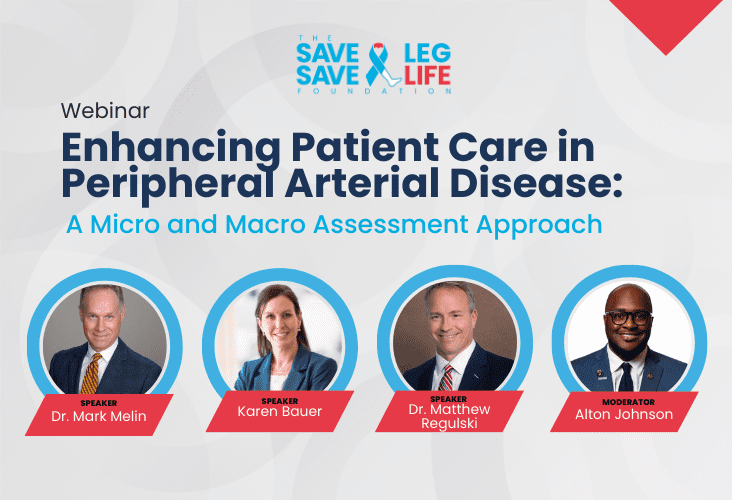
Register here to watch recording of the webinar and get educational credits
Register to watch
Register here to watch recording of the webinar and get educational credits
Register to watchHow is this acceptable?
The increasing rates of both diabetes and related complications is a world-wide phenomenon, with a rise in lower extremity amputations a particularly worrisome trend. It has been reported by both David Allie, MD and the SAGE Group among others, that in the United States, approximately 50% of lower extremity amputations are performed as a first line “treatment”, without prior vascular testing or other effort to explore limb preserving options.
“Prevention of lower extremity amputation is more cost effective than amputation and its associated costs.”
– Dr. Desmond Bell
Additional research by the SAGE Group, a private consulting group focused on peripheral arterial and venous disease, indicates that prevention of lower extremity amputation is more cost effective than amputation and its’ associated costs.
A disconnect exists between academia, the medical community and the high-risk patient population. The Save A Leg, Save A Life Foundation is committed to bridging the gap, and an important facet is provider education.
Some examples of provider education include:
- The necessity for vascular screening prior to amputation
- Workflow/triaging and collaboration between specialties
- Topics pertaining to revascularization concepts/techniques
- The economic benefits of amputation prevention
- Case studies demonstrating best practices in wound care, interventions, and limb salvage approaches
If you are interested in learning more, contact us.
Call a time-out…the SALSAL Challenge
Every day, non-traumatic amputations are performed within hospitals on patients without prior vascular testing. According to the American Heart Association Journal, “A number of evidence-based diagnostic and therapeutic approaches for PAD can reduce amputation risk. However, their implementation and adherence are suboptimal.”*
The solution is powerful and simple: Calling a time out.
The SALSAL Challenge requires that any hospitalized patient recommended for a lower extremity amputation must first have vascular testing and further assessment to address whether endovascular or surgical intervention are options to restore blood flow.
Adopting such a policy within hospitals will reduce preventable amputations in a similar way that time-out policies, introduced by The Joint Commission in 2003, have prevented countless wrong-site, wrong-person, and wrong-procedure surgeries over the years. As stated in the Bulletin of the American College of Surgeons, “While initially viewed as a safety measure to prevent harm as a result of operating on the wrong patient or the wrong site or performing the wrong procedure, time-outs evolved to include quality patient care and enhanced performance of the surgical team.”**
AMPUTATION RATES DECREASED SIGNIFICANTLY
The SALSAL time-out was introduced by Dr. Desmond Bell while addressing a group of SALSAL volunteers in North Carolina several years ago. A question raised by a nurse volunteer regarding what could be done to reduce amputations in her hospital was met with the answer, “Make sure that before any patient can be scheduled for an amputation, they must first have vascular testing performed.” As a result of this conversation, that hospital adopted such a policy, with amputation rates “decreased significantly” after one year of implementation.
The Foundation recommends that hospitals adopt this policy and collect data which compares amputations from the year previous to the year after adoption of The SALSAL Challenge. Compilation of data to demonstrate the efficacy of this concept will likely prove to be invaluable to patients and the health care system alike.
*Reducing Nontraumatic Lower-Extremity Amputations by 20% by 2030: Time to Get to Our Feet: A Policy Statement From the American Heart Association, Mark A. Creager, Kunihiro Matsushita, Shipra Arya, Joshua A. Beckman, Sue Duval, Philip P. Goodney, J. Antonio T. Gutierrez, John A. Kaufman, Karen E. Joynt Maddox, Amy W. Pollak, Aruna D. Pradhan, Laurie P. Whitsel and On behalf of the American Heart Association Advocacy Coordinating Committee. Originally published 25 Mar 2021https://doi.org/10.1161/CIR.0000000000000967 Circulation. 2021;143:e875–e891
**Time-Outs And Their Role In Improving Safety And Quality In Surgery, by CARLOS A. PELLEGRINI, MD, FACS, FRCSI(HON), FRCSENG(HON), FRCSED(HON), PUBLISHED JUNE 1, 2017 in Bulletin of the American College of Surgeons



